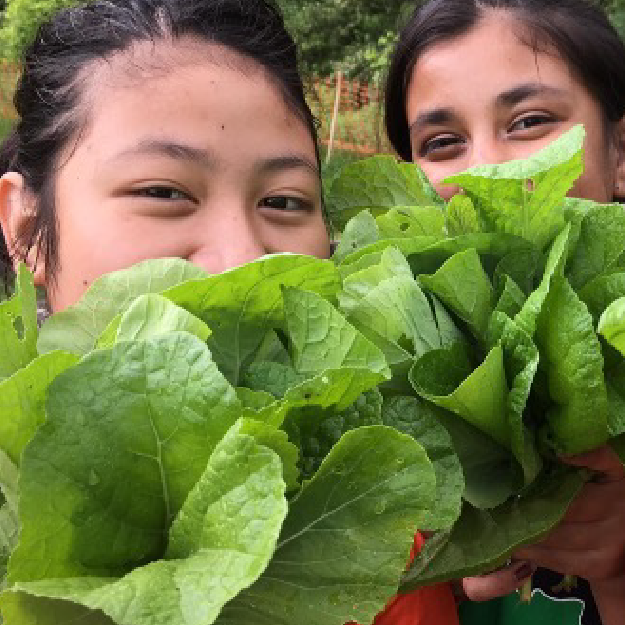Our Network
School Profile
Spotlight School: Aiken New Tech High School
Cincinnati, Ohio
Cincinnati Public Schools
Focus Area
Purposeful Assessment
Redefining Inclusive Culture through Agriculture
Aiken High School in Cincinnati Ohio is redefining the traditional concept of project-based learning through its student-led community garden. This outdoor, immersive classroom fosters a culturally sustaining educational environment that brings together academic learning and community involvement, helping students grow not just plants, but vital skills for their futures.
At Aiken High School, students dive into hands-on learning with the community garden – they aren’t just studying; they’re actively cultivating and maintaining the garden, applying their knowledge in real-world settings. This experience enhances their social-emotional development and equips them with essential skills for college, careers, and civic engagement.



From Garden to Community Business Ventures
The learning at Aiken doesn’t stop at the garden. Aiken’s students have applied their learning to real-world environments by turning their garden produce into a thriving agribusiness. As environmental justice advocates, students engineer an ethically sourced, student-roasted, and freshly brewed Career and Technical Student Organization (CTSO) agribusiness. This initiative not only promotes environmental sustainability but also equips students with entrepreneurial skills and real-world business experience.
Moreover, Aiken New Tech High School provides students with the option of integrating culinary skills with the food grown in their on-campus community garden. The Agriscience and Agriproduction Career
Tech Pathway at Aiken encompasses a partnership with La Soupe to teach the transformation of raw ingredients into delicious meals, aiming to reduce food waste and combat food insecurity. The Agriculture curriculum’s “Food Science” component equips learners with the principles of biology, chemistry, and physics to research, develop, produce, process, and distribute food products meeting quality assurance standards in a secure and safe system.
Teachers at Aiken address these standards by engaging students in coffee roasting with La Terza and training them to be GAP (Good Agriculture Practices) Certified. This comprehensive approach ensures that students are equipped with a diverse skill set, preparing them for success in the dynamic and evolving fields of agriculture, culinary arts, and environmental sustainability.
Aiken students also have the opportunity to showcase their projects at national conferences, such as the National FFA Convention, demonstrating premier leadership and evolution throughout their high school years. These experiences prepare students for success in college, career, and civic life, fostering a sense of accountability and ownership of their learning journey.
Why It Works
Aiken’s whole-school model approach to effectively teach agriculture as a career tech pathway relies on several evidence-based supports that promote academic achievement and holistic development:
Prior Knowledge: Leveraging students’ backgrounds in subsistence and/or commercial agriculture is beneficial. Research shows that connecting new learning to students’ prior experiences enhances comprehension and retention (Bransford, Brown, & Cocking, 2000). Students’ existing knowledge in agriculture provides a solid foundation upon which new concepts can be built, making learning more meaningful and effective.
Hands-On Learning: Reality-based, kinesthetic learning is crucial in agriculture education. Studies indicate that hands-on learning experiences significantly improve students’ understanding and retention of material (Haury & Rillero, 1994). Practical activities such as planting, harvesting, and managing livestock make theoretical concepts tangible, reinforcing learning through direct application and engagement.
Modalities of Learning (SIOP): The Sheltered Instruction Observation Protocol (SIOP) modalities of Reception, Production, and Interaction align well with career tech language learning in agriculture. Research by Echevarria, Vogt, and Short (2010) demonstrates that SIOP strategies effectively enhance content comprehension and language development for English language learners. These modalities encourage active participation and ensure that students are not just passive recipients of information but are also involved in producing and interacting with the content.
Outdoor Education: Research supports the significant benefits of outdoor learning environments. Studies by Dillon et al. (2006) and Lieberman and Hoody (1998) show that outdoor education can enhance student engagement, improve academic performance, and foster a greater appreciation for the environment. In agriculture education, outdoor settings like fields, gardens, and farms provide dynamic learning environments where students can directly apply what they learn in real-world contexts.
Culturally Relevant Content: Agriculture provides a platform to leverage diverse perspectives through its connection to land, history, access to food, and community knowledge. By integrating students’ personal and familial ties to land, programs reflect the assets from student communities. Culturally responsive teaching, as highlighted by Gay (2010), fosters an inclusive learning environment that respects and incorporates the assets leveraged from students’ cultural backgrounds. This relevance boosts student motivation and engagement, as they see their own cultures and experiences valued in their education.
At Aiken High School, education is more than textbooks. It’s about preparing students for the real world. By blending academic rigor with practical experiences, Aiken High School ensures students are ready for the challenges and opportunities of the 21st century.
Are you an NTN school interested in the Spotlight Schools program? Learn more here!

References:
Bransford, J. D., Brown, A. L., & Cocking, R. R. (2000). How People Learn: Brain, Mind, Experience, and School. National Academy Press.
Echevarria, J., Vogt, M., & Short, D. (2010). Making Content Comprehensible for English Learners: The SIOP Model. Pearson.
Gay, G. (2010). Culturally Responsive Teaching: Theory, Research, and Practice. Teachers College Press.
Haury, D. L., & Rillero, P. (1994). Perspectives of Hands-On Science Teaching. ERIC Clearinghouse for Science, Mathematics, and Environmental Education.
Lieberman, G. A., & Hoody, L. L. (1998). Closing the Achievement Gap: Using the Environment as an Integrating Context for Learning. State Education and Environment Roundtable.
Dillon, J., Rickinson, M., Teamey, K., Morris, M., Choi, M. Y., Sanders, D., & Benefield, P. (2006). The value of outdoor learning: evidence from research in the UK and elsewhere. School Science Review, 87(320), 107-111.


